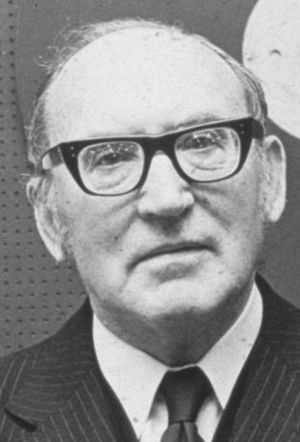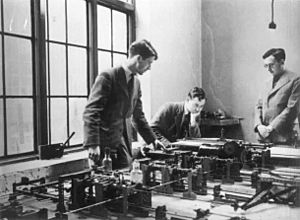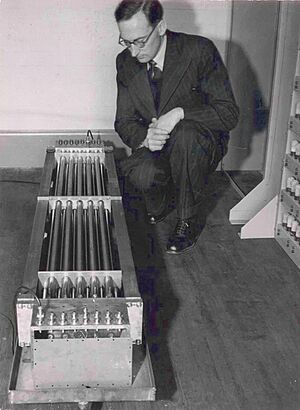Maurice Wilkes facts for kids
Quick facts for kids
Maurice Wilkes
FRS FREng
|
|
|---|---|

Maurice Wilkes in 1980
|
|
| Born |
John Maurice Vincent Wilkes
26 June 1913 Dudley, Worcestershire, England
|
| Died | 29 November 2010 (aged 97) Cambridge, Cambridgeshire, England
|
| Education | King Edward VI College, Stourbridge |
| Alma mater | University of Cambridge (MA, PhD) |
| Known for | Cache memory |
| Spouse(s) |
Nina Twyman
(m. 1947; |
| Children | one son, two daughters |
| Awards |
|
| Scientific career | |
| Fields | Computer Science |
| Institutions |
|
| Thesis | The reflexion of very long wireless waves from the ionosphere (1939) |
| Doctoral advisor | John Ashworth Ratcliffe |
| Doctoral students |
|
Sir Maurice Vincent Wilkes (26 June 1913 – 29 November 2010) was a very important British computer scientist. He is best known for designing and helping to build the Electronic Delay Storage Automatic Calculator (EDSAC). This was one of the first computers that could store its own programs. He also invented microprogramming, a clever way to control a computer's main brain, called the central processing unit (CPU). At the time of his death, Wilkes was a respected professor at the University of Cambridge.
Contents
Early Life and Education
Maurice Wilkes was born in Dudley, England, in 1913. He was the only child of Ellen and Vincent Joseph Wilkes. He grew up in Stourbridge and went to King Edward VI College, Stourbridge. While at school, his chemistry teacher introduced him to amateur radio, which sparked his interest in electronics.

From 1931 to 1934, he studied mathematics at St John's College, Cambridge. In 1936, he earned his PhD in physics. His research was about how very long radio waves travel through the ionosphere, a part of Earth's upper atmosphere. After his PhD, he became a junior teacher at the University of Cambridge. He helped set up a new computing laboratory there. During World War II, he joined the military and worked on radar technology and operational research.
Building Early Computers
In 1945, Maurice Wilkes became the director of the University of Cambridge Mathematical Laboratory. This lab later became known as the Computer Laboratory.
One day, a visitor named Leslie Comrie showed Wilkes a special document. It was a description of a new computer called the EDVAC, which was being built in the United States. Wilkes had to read it very quickly because he had to return it the next day. He realized immediately that this document described the future of computers. He decided he wanted to build such a machine himself. In 1946, Wilkes traveled to the United States to learn more about these new computers. On his way back to England, he drew detailed plans for a computer that would become EDSAC.
The EDSAC Computer
Because his lab had its own money, Wilkes could start building his computer right away. He named it EDSAC. His main goal was to create a working computer for the university, not necessarily the most advanced one. So, he used only proven methods for building each part. This made EDSAC slower and smaller than some other computers being planned.
However, EDSAC was the second practical computer that could store its own programs. It started working successfully in May 1949. This was more than a year before the much larger EDVAC was finished. In 1950, Wilkes and his colleague David Wheeler used EDSAC to solve a complex math problem related to gene frequencies in biology. This was the first time a computer was used to solve a problem in the field of biology.
Microprogramming and Other Innovations
In 1951, Wilkes came up with the idea of microprogramming. He realized that the central processing unit (CPU), which is like the computer's brain, could be controlled by a tiny, special computer program stored in fast memory. This idea made designing CPUs much simpler. Microprogramming was first shown in 1951 and later published in 1955.
This concept was first used in the EDSAC 2 computer. EDSAC 2 also used interchangeable parts for each bit of the processor, making it easier to build and fix. The next computer for his lab was the Titan, built with Ferranti Ltd starting in 1963. Titan was important because it supported the UK's first time-sharing system. This system allowed many people to use the computer at the same time, giving more students and researchers access to computing power. It even helped with early CAD (Computer-aided design) systems.
The Titan's operating system had a special feature: it could control access based on the program being used, not just the user. It also introduced a password encryption system, which was later used by Unix. Its programming system also had an early way to keep track of different versions of programs.
Wilkes is also known for ideas like macros (shortcuts for common commands) and subroutine libraries (collections of useful code). These ideas made programming much easier and helped lead to modern programming languages. Later, Wilkes worked on distributed computing, where many computers work together. In the late 1960s, he also became interested in capability-based computing, and his lab built a unique computer called the Cambridge CAP.
In 1974, Wilkes saw a special computer network in Switzerland that used a ring shape to connect devices. His lab used a similar idea to share devices like printers. Eventually, this led to commercial partnerships, and similar technology became widely used in the UK.
Awards and Recognition
Maurice Wilkes received many important awards and honors for his work. He was made a Knight Bachelor, which means he could be called "Sir." He was also a Fellow of the Royal Academy of Engineering and a Fellow of the Royal Society, which are very high honors for scientists and engineers in the UK.
Wilkes was one of the people who started the British Computer Society (BCS) and was its first president from 1957 to 1960. In 1967, he received the Turing Award, which is like the Nobel Prize for computer science. The award recognized him for building EDSAC and for writing an important book about preparing programs for computers, which introduced the idea of program libraries.
He received many other awards, including the Faraday Medal in 1981 and the Mountbatten Medal in 1997. The Maurice Wilkes Award, given each year to a young computer scientist or engineer for an outstanding contribution to computer architecture, is named after him.
In 1980, he retired from his teaching and leadership roles at the Computer Laboratory. He then joined Digital Equipment Corporation, a large computer company in the USA. In 1986, he returned to England and worked with Olivetti, another technology company. In 2000, he was officially knighted. In 2001, he was honored by the Computer History Museum for his contributions to computer technology, including his early machine designs, microprogramming, and the Cambridge Ring network. He continued to be an emeritus professor at the University of Cambridge until his death.
Publications
Maurice Wilkes wrote several important books about computers and science:
- Oscillations of the Earth's Atmosphere (1949)
- Preparation of Programs for an Electronic Digital Computer (1951), with D. J. Wheeler and S. Gill
- Automatic Digital Computers (1956)
- A Short Introduction to Numerical Analysis (1966)
- Time-sharing Computer Systems (1968)
- The Cambridge CAP Computer and its Operating System (1979), with R. M. Needham
- Memoirs of a Computer Pioneer (1985)
- Computing Perspectives (1995)
Personal Life
Maurice Wilkes married Nina Twyman in 1947. She passed away in 2008. Maurice Wilkes died in 2010. He had one son and two daughters.
See also
 In Spanish: Maurice Wilkes para niños
In Spanish: Maurice Wilkes para niños


